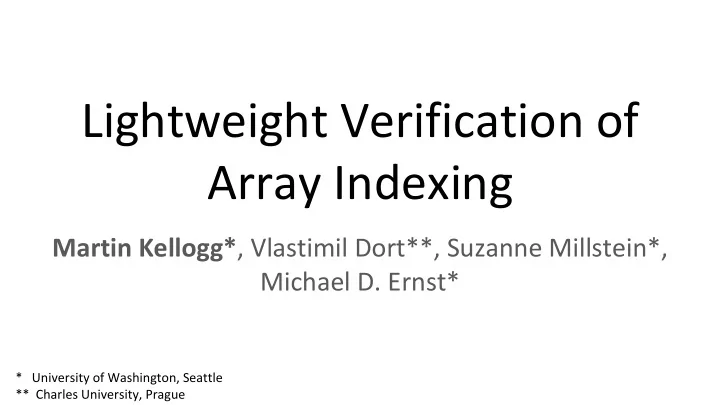

Lightweight Verification of Array Indexing Martin Kellogg* , Vlastimil Dort**, Suzanne Millstein*, Michael D. Ernst* * University of Washington, Seattle ** Charles University, Prague
The problem: unsafe array indexing ● In unsafe languages (C): buffer overflow! ● In managed languages (Java, C#, etc.): exception, program crashes 2
The state of the art Strength of guarantees Practical for developers 3
The state of the art Coq KeY Clousot Strength of guarantees Practical for developers 4
The state of the art Coq KeY Clousot Strength of guarantees Coverity FindBugs Practical for developers 5
The state of the art Coq KeY Clousot The Index Checker (this talk) Strength of guarantees Coverity FindBugs Practical for developers 6
Problems with complex analyses - false positives - annotation burden - complex analyses are hard to predict 7
Problems with complex analyses - false positives ● bounds checking is hard → complex analysis ● complex analysis → harder to implement ● harder to implement → more false positives - annotation burden - complex analyses are hard to predict 8
Problems with complex analyses - false positives ● bounds checking is hard → complex analysis ● complex analysis → harder to implement ● harder to implement → more false positives - annotation burden ● complex analysis → complex annotations - complex analyses are hard to predict 9
Problems with complex analyses - false positives ● bounds checking is hard → complex analysis ● complex analysis → harder to implement ● harder to implement → more false positives - annotation burden ● complex analysis → complex annotations complex analyses are hard to predict - 10
Insight: Fundamental problem is complex analyses! 11
Cooperating simple analyses Solve all three problems: 12
Cooperating simple analyses Solve all three problems: ● simpler implementation → fewer false positives 13
Cooperating simple analyses Solve all three problems: ● simpler implementation → fewer false positives ● simpler abstractions → easier to write annotations 14
Cooperating simple analyses Solve all three problems: ● simpler implementation → fewer false positives ● simpler abstractions → easier to write annotations ● simpler analysis → simpler to predict 15
Proving an array access safe T[] a = …; int i = …; ... a[i] ... We need to show that: ● i is an index for a 16
Proving an array access safe T[] a = …; int i = …; ... a[i] ... We need to show that: ● i is an index for a ● i ≥ 0 ● i < a.length 17
Proving an array access safe T[] a = …; int i = …; ... a[i] ... We need to show that: ● i is an index for a A lower bound on i ● i ≥ 0 An upper bound on i ● i < a.length 18
A type system for lower bounds T @LowerBoundUnknown int i ↑ ↑ i ≥ -1 @GTENegativeOne int i ↑ ↑ i ≥ 0 @NonNegative int i ↑ ↑ i ≥ 1 @Positive int i 19
A type system for lower bounds T @LowerBoundUnknown int i ↑ ↑ i ≥ -1 @GTENegativeOne int i ↑ ↑ i ≥ 0 @NonNegative int i ↑ ↑ i ≥ 1 @Positive int i 20
A type system for upper bounds if (i >= 0 && i < a. length ) { a[i] = ... } 21
A type system for upper bounds if (i >= 0 && i < a. length ) { a[i] = ... } i < a.length @LTLengthOf (“a”) int i 22
Type systems Linear inequalities Minimum lengths i < j a.length > 10 Negative indices Lower bounds | i | < a.length i ≥ 0 Equal lengths Upper bounds a.length = b.length i < a.length 23
Type systems Linear inequalities Minimum lengths i < j a.length > 10 Negative indices Lower bounds | i | < a.length i ≥ 0 Equal lengths Upper bounds a.length = b.length i < a.length 24
A type system for minimum array lengths if (a. length >= 3) { a[2] = ...; } 25
A type system for minimum array lengths if (a. length >= 3) { a[2] = ...; } a.length ≥ i T @MinLen (i) [] a 26
Evaluation Three case studies: ● Google Guava (two packages) ● JFreeChart ● plume-lib Comparison to existing tools: ● FindBugs, KeY, Clousot 27
Case Studies Guava JFreeChart plume-lib Total Lines of code 10,694 94,233 14,586 119,503 Bugs found 5 64 20 89 Annotations 510 2,938 241 3,689 False positives 138 386 43 567 Java casts 222 2,740 219 3,181 28
Comparison to other tools: confirmed bugs Approach Bug finder Verif. w/ solver Abs. interpret. Types Tool Index Checker FindBugs KeY Clousot True Positives False Negatives Time (100k LoC) 29
Comparison to other tools: confirmed bugs Approach Bug finder Verif. w/ solver Abs. interpret. Types Tool Index Checker FindBugs KeY Clousot True Positives False Negatives Time (100k LoC) ~10 minutes ~1 minute cannot scale ~200 minutes 30
Comparison to other tools: confirmed bugs Approach Bug finder Verif. w/ solver Abs. interpret. Types Tool Index Checker FindBugs KeY Clousot True Positives 18/18 0/18 9/18 16/18 False Negatives 0/18 18/18 1/18 2/18 Time (100k LoC) ~10 minutes ~1 minute cannot scale ~200 minutes 31
Using the Index Checker ● Distributed with Checker Framework www.checkerframework.org 32
Contributions ● A methodology: simple, cooperative type systems ● An analysis: abstractions for array indexing ● An implementation and evaluation for Java ● Verifying the absence of array bounds errors in real codebases (and finding bugs in the process!) 33
Recommend
More recommend